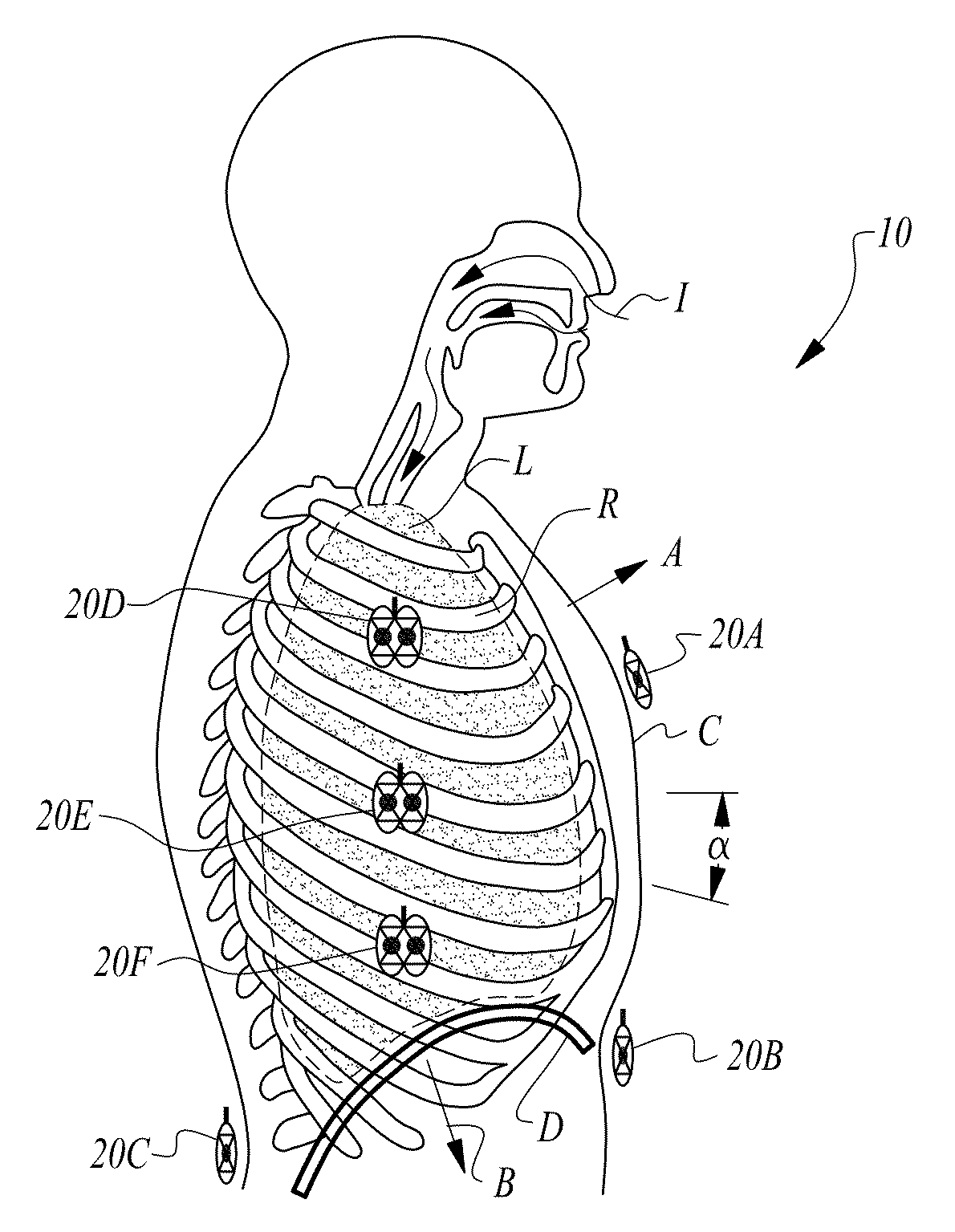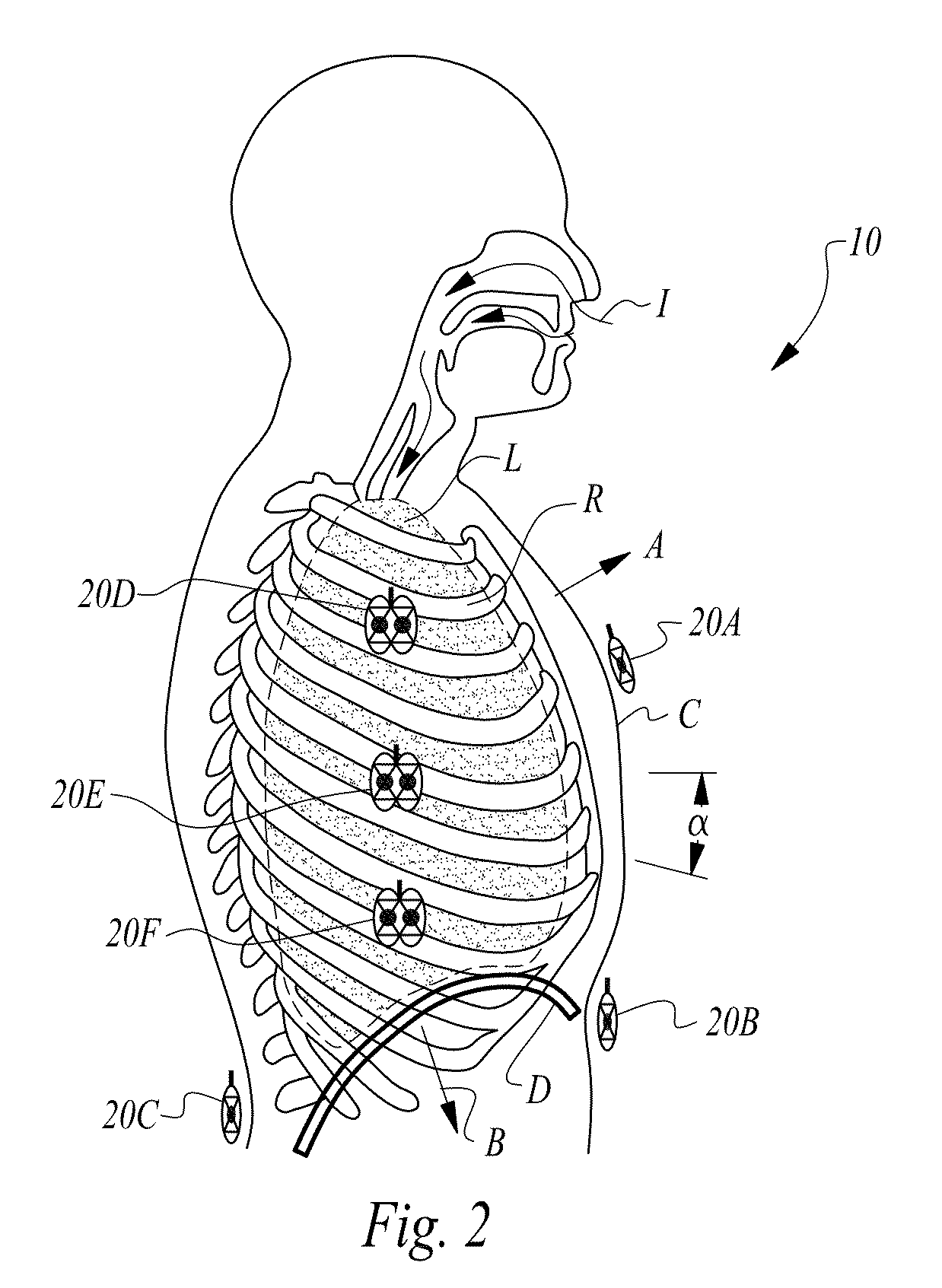Apparatus and method for continuous noninvasive measurement of respiratory function and events
- Summary
- Abstract
- Description
- Claims
- Application Information
AI Technical Summary
Benefits of technology
Problems solved by technology
Method used
Image
Examples
first embodiment
[0132]In a first embodiment, as illustrated in FIGS. 2 and 3, the apparatus 10 of the present invention captures and measures the motion of multiple anatomical elements during a respiratory cycle, where the motion is induced by various types of breathing. One or more sensors 20 transmit signals toward target areas and capture reflected signals which are then processed by the sensor to develop a qualitative and quantitative assessment of respiratory performance and health. To understand the operation of the apparatus 10 of the present invention, it is helpful for the reader to understand fundamental aspects of the physiological mechanics of breathing and how the apparatus 10 uniquely evaluates and tracks movement of the anatomical structure to generate various relevant respiratory parameters or metrics. The subsequent discussion of breathing mechanics, taken in conjunction with the respiratory disease information provided in the Background section of this document, will provide an un...
embodiment 100
[0161]The wireless sensors 120 are deployed to target or interrogate various portions or regions of the upper thorax associated with respiratory functionality. For example, wireless sensor 120C is located in the center of the chest adjacent a midpoint of the sternum to capture both cardiac and respiratory motion. Five additional sensors 120L are located adjacent specific portions of a subject's lungs L to monitor the performance and functionality of each lobe of each lung L independently of the other lobes. Additional wireless sensors 120S are deployed along the subject's side in proximity to each lobe of each lung to provide an alternative measure of motion and functionality for each lobe. In addition to the wireless sensors 120 deployed about the chest of the subject, the present multi-sensor embodiment 100 also includes a wireless sensor 120W preferably located at the middle of a subject's waist, held by a belt or waistband 112 to target movement of the diaphragm D. Sensor 120W m...
embodiment 200
[0165]Following are illustrative examples of specific anatomical motion to be monitored and tracked by the sensors 220. This motion is correlated and aggregated to develop the various measures and metrics of respiratory performance relative to various disease states. The data collected may be aggregated and disaggregated as necessary to support a plethora of different analyses relative to the condition being evaluated. For example, during deep breathing, one would expect the manubrium sterni to move 30 mm in an upward direction and 14 mm in a forward direction during inspiration. Additionally, the width of the subcostal angle, at a level of 30 mm below the articulation between the body of the sternum and the xiphoid process, is increased by 26 mm. Further, the umbilicus is retracted and drawn upward for a distance of 13 mm. By measuring these and other movements induced by respiration, the multiple wired sensor embodiment 200 of the present invention obtains mechanical motion data t...
PUM
 Login to View More
Login to View More Abstract
Description
Claims
Application Information
 Login to View More
Login to View More - R&D
- Intellectual Property
- Life Sciences
- Materials
- Tech Scout
- Unparalleled Data Quality
- Higher Quality Content
- 60% Fewer Hallucinations
Browse by: Latest US Patents, China's latest patents, Technical Efficacy Thesaurus, Application Domain, Technology Topic, Popular Technical Reports.
© 2025 PatSnap. All rights reserved.Legal|Privacy policy|Modern Slavery Act Transparency Statement|Sitemap|About US| Contact US: help@patsnap.com



